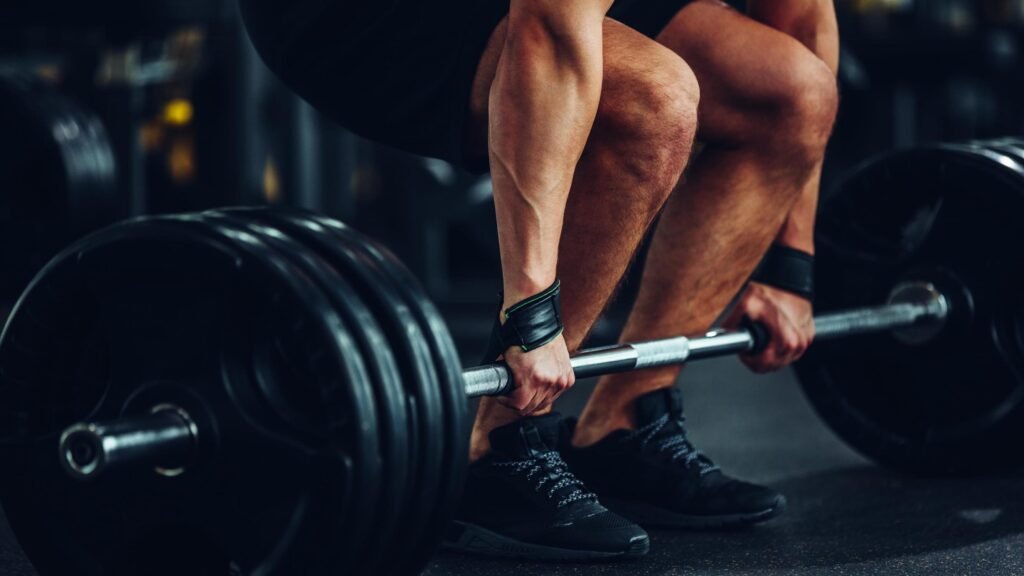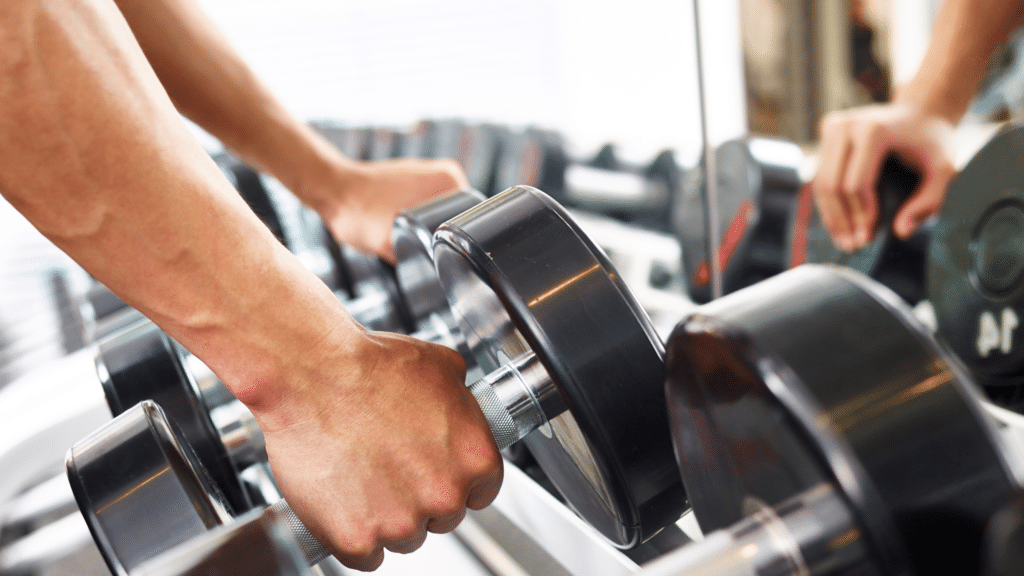Understanding the intricacies of sets and reps is foundational for anyone looking to maximize their powerlifting or bodybuilding results. Properly manipulating your set and rep ranges can mean the difference between lackluster strength gains or muscle growth and truly incredible progress.
In this all-encompassing guide, we’ll explore everything you need to know about utilizing sets and reps for powerlifting and bodybuilding success. You’ll learn about optimal set and rep ranges for each sport, strategies for progressing over time, when to incorporate advanced techniques, and how to balance your training variables.
Whether your goal is to add 100lbs to your squat or pack on pounds of mass, dialing in your sets and reps is essential. Let’s get started!

Table of contents
What Are Sets and Reps?
Before jumping into sport-specific recommendations, let’s clearly define what sets and reps are:
- Sets – The number of times you repeat an exercise consecutively before resting. For example, completing a set of 10 squats, resting, and doing another set of 10 squats.
- Reps – The number of times you repeat the movement per set. For instance, in those sets of 10 squats, you completed 10 reps per set.
It’s important to note that your set and rep range dramatically impacts training volume and dictates the training effect. Volume refers to the total amount of work done per workout, which is calculated by multiplying sets x reps x weight lifted.
Increasing volume over time via adding sets, reps, or weight is known as progressive overload – one of the core tenets of strength and muscle gains. However, balancing too much volume also heightens injury risk and overtraining potential.
That’s why selecting the appropriate set and rep range for your sport and goals is critical.

Training Volume Shapes Muscle Fiber Type Ratio
The volume, intensity, and repetition range used in your sets and reps directly impact muscle fiber type ratio changes over time. Our muscles contain a blend of slow-twitch (Type I) and fast-twitch (Type II) muscle fibers.
Slow-twitch fibers contract slower but are very fatigue-resistant – enabling them to sustain high workloads. Fast-twitch fibers contract explosively but fatigue quicker. They grow larger with mechanical tension and proper manipulation of training volume.
Higher Volume Training: Performing sets and reps in the 8-20 rep range with shorter rest periods increases time under tension and metabolic markers. This signals the body to shift towards greater proportions of slow-twitch fibers.
The increased capillary and mitochondrial density that results also enhances muscular endurance. This is advantageous for bodybuilders seeking muscle growth and definition.
Lower Volume Training: Alternatively, focusing on the 1-5 rep range with heavier loads and longer rest leads to fast-twitch fiber dominance. The enhanced neural efficiency and strength of fast-twitch fibers perfectly suits powerlifting.
This fiber-type shift also maximizes whole-muscle hypertrophy versus sarcoplasmic growth. Tendon and ligament strength increases as well to support heavier weights.
So, manipulating set and rep volumes over time can optimize fiber ratios for your chosen sport. Next, let’s cover how powerlifting goals dictate ideal rep ranges.

Powerlifting: Optimal Sets and Reps
Powerlifting is centered around the squat, bench press, and deadlift. Competitors aim to lift the heaviest possible weight on these big, compound lifts. Thus, powerlifters structure their training to maximize absolute strength and practice lifting near-maximal loads.
Powerlifting Goals Dictate Rep Ranges
The predominantly fast-twitch muscle fibers powerlifters possess lend themselves perfectly to lifting very heavy weight. But they tire quickly – making ideal rep ranges quite low:
1-5 Reps: Enables powerlifters to handle heavy loads close to their 1 rep max (1RM), developing maximum strength. Sets across 1-3 reps specifically hone neural efficiency in recruiting muscle fibers.
6-8 Reps: Allows for slightly higher volume while still emphasizing heavy loads around 80-85% 1RM for strength gains. Also helps spur some muscle growth. These rep ranges are typically employed for assistance exercises (i.e., dips, pull-ups, rows, etc.).
You’ll notice even higher rep ranges aren’t ideal for powerlifting. More than eight reps per set substantially lightens the loads used, shifting away from maximal strength development.
Optimal Number of Sets
When it comes to number of sets, research indicates 3-6 sets per exercise is optimal for powerlifters. Anymore provides diminishing returns:
- 3 sets offers a solid baseline for progression.
- 4-5 sets maximizes strength gains for most.
- 6 sets should be used sparingly for specialization in a struggling lift.
Spreading these sets out over multiple sessions per week can maximize powerlifting-specific adaptations as well. Just be wary of overuse injuries or overtraining when increasing your training frequency.
Adequate Rest Between Sets is Crucial
Finally, do not overlook the importance of rest between sets for powerlifters. These athletes are handling very heavy loads, necessitating longer rest periods for recovery:
- 3-5 minutes between sets allows the nervous system to regenerate and primes you for maximal force output again. This enables the use of heavy weights across all sets.
Some powerlifters may utilize advanced techniques like drop sets sparingly, in which case rest periods are shorter by nature. But for the bulk of your training, longer rest is best.

Bodybuilding: Optimal Sets and Reps
In contrast to powerlifting, bodybuilding focuses on maximizing long-term muscle growth rather than strength. This necessitates substantially higher volumes and additional repetition ranges for hypertrophy. Bodybuilders aim to sculpt their physique by increasing muscle size, symmetry, and definition, which requires a different training approach compared to powerlifters.
Muscle Growth for Bodybuilding
While powerlifters have primarily fast-twitch fibers, bodybuilders possess a more balanced ratio of fast-twitch and slow-twitch muscle fibers. Slow-twitch fibers are more resistant to fatigue and respond well to higher-volume training, which is essential for maximizing muscle growth. These fibers grow bigger with metabolic stress, requiring higher volume and longer time under tension.
Time under tension and fatiguing muscles is key for bodybuilding. By keeping the muscles under tension for an extended period, bodybuilders can create a hypoxic environment that stimulates the release of anabolic hormones, such as growth hormone and insulin-like growth factor 1 (IGF-1). These hormones promote muscle protein synthesis and contribute to muscle growth.
Rep Ranges for Bodybuilding
Thus, ideal rep ranges for bodybuilding span:
8-12 Reps: This rep range enables bodybuilders to use weights around 70-80% of their 1 rep max, leading to considerable metabolic stress and muscle damage. The mechanical tension and muscle damage caused by this rep range stimulate satellite cell activation and muscle fiber hypertrophy. Bodybuilders typically perform 3-4 sets of 8-12 reps per exercise, with short rest periods (60-90 seconds) to maintain metabolic stress.
12-20 Reps: Using lighter loads of 50-70% 1RM, this higher rep range further fatigues the muscles and promotes sarcoplasmic hypertrophy. Sarcoplasmic hypertrophy involves an increase in the volume of the fluid-like substance (sarcoplasm) within the muscle cells, leading to increased muscle size and definition. Performing sets of 20 reps is excellent for achieving “the pump,” a temporary increase in muscle size due to increased blood flow and metabolic byproducts.
In addition to these rep ranges, bodybuilders also incorporate various advanced training techniques to maximize muscle growth. These techniques include:
- Drop sets: Performing a set to failure, then immediately reducing the weight and continuing to perform more reps until failure.
- Supersets: Performing two exercises back-to-back with minimal rest in between to increase intensity and metabolic stress.
- Rest-pause sets: Performing a set to failure, resting for a short period (10-15 seconds), and then performing additional reps to failure.
While lower rep ranges (1-5 reps) can still build muscle, research indicates that the 8-20 rep range optimizes hypertrophy for bodybuilders. Lower reps primarily build strength and neural adaptations rather than muscle size. By focusing on the 8-20 rep range and incorporating advanced training techniques, bodybuilders can maximize muscle growth and sculpt their desired physique.

Progressing Your Sets and Reps Over Time
Whether your goal is pure strength or mass, the key to long-term gains is progressively overloading your muscles. Progressive overload is a fundamental principle in resistance training that involves gradually increasing the stress placed on your muscles over time. This can be achieved by manipulating variables such as volume (sets and reps), weight (intensity), and difficulty (exercise complexity). By continually challenging your muscles with increased demands, you stimulate adaptations that lead to improved strength and muscle growth.
Sets and reps serve as excellent metrics for adding training stress. Here’s how to safely progress them:
Linear Progression
The simplest tactic for progressive overload is adding weight each session, known as linear progression. The goal is to achieve the desired number of reps for all sets before increasing the weight. Once you reach the top of your rep range for all sets, increase the weight by a small increment (e.g., 5-10lbs for compound exercises, 2.5-5lbs for isolation exercises) and work back up to the target rep range.
For example, if your goal is to complete 3 sets of 10 reps on squats, and you successfully achieve this, the next workout, you would add 5-10lbs to the bar and aim to work back up to 3 sets of 10 reps with the new weight. Rinse and repeat this process until the weights become too heavy to maintain proper form or reach the desired rep range.
Double Progression
Double progression is a more gradual approach that alternates between adding weight and increasing reps week-to-week. This method helps prolong linear gains and allows for more sustainable progress. With double progression, you increase the weight one week while keeping the reps the same, then focus on increasing reps the following week while maintaining the same weight.
For instance, if you squat 3 sets of 10 reps at 200lbs in week 1, you would add 5lbs in week 2 and aim for 3 sets of 10 reps at 205lbs. In week 3, you would keep the weight at 205lbs but strive to perform 3 sets of 11 reps. This cycle continues, alternating between adding weight and increasing reps.
Periodization
As you become more advanced, linear progression and double progression may lead to plateaus. At this stage, periodization becomes a valuable tool for continued progress. Periodization involves structuring your training into specific blocks or cycles, each focusing on different aspects of performance, such as strength, hypertrophy, or endurance.

One common approach is to divide your training into mesocycles, which typically last 4-8 weeks. During each mesocycle, you concentrate on a specific goal. For example, you might dedicate one mesocycle to higher reps (8-15) and increased volume to prioritize metabolic stress and muscle growth. The following mesocycle could focus on lower reps (1-5) and heavier weights to emphasize strength development. By periodically changing the emphasis of your training, you can prevent plateaus and maintain long-term progress.
Signs to Change Sets and Reps
While progressive overload is essential, it’s crucial to listen to your body and recognize when it’s time to adjust your set and rep scheme. Here are some indicators that it may be time for a change:
- Reaching strength or muscle plateaus: If you find yourself unable to increase weight or reps for multiple consecutive workouts, it could signify that your current set and rep scheme has run its course. Plateaus are a normal part of training, and changing your approach can help break through them.
- Consistently missing reps: If you regularly fail to complete the desired number of reps, it may indicate that the weight is too heavy or that you’ve reached a limit in your current rep range. Consider reducing the weight or adjusting your rep scheme to maintain proper form and avoid injury.
- Overuse pain or injury: If you experience persistent pain or develop an injury related to your training, it’s a clear sign that you need to modify your sets and reps. Reduce the weight, increase rest periods, or switch to a higher rep range to allow for recovery and prevent further damage.
- Lack of motivation: Performing the same set and rep scheme for an extended period can lead to boredom and decreased motivation. If you find yourself dreading your workouts or losing interest, it’s time to introduce variety. Changing your sets and reps, trying new exercises, or experimenting with different training styles can reignite your passion and keep you engaged.
Remember, the key to long-term success is finding a balance between progressive overload and listening to your body. Be patient, consistent, and willing to adapt your training as needed. By carefully progressing your sets and reps over time, you’ll maximize your strength and muscle gains while minimizing the risk of plateaus and injury.

Incorporating Advanced Set and Rep Techniques
Sprinkling in advanced training methods can offer a powerful change of pace while targeting different facets of strength and muscle development.
Drop Sets
Drop sets involve reducing the weight and immediately pumping out additional reps with less rest. For example, complete 8 reps on squat, remove 10-20% of weight, then bang out 6-8 more reps.
Supersets
Supersets pair two exercises back-to-back targeting opposing muscle groups with minimal rest. For instance, combine chest flyes with bent over rows. This heightens conditioning and time efficiency.
Pyramid Sets
Start light for higher reps then progressively increase weight each set while reducing reps – finishing with a heavy top set of 1-5 reps. Excellent for strength gains.
Rest-Pause Sets
Lift a near maximal load for 2-3 reps, rack briefly for 10-30 seconds, then grind out another 1-2 reps. Repeating this 3-5 times builds tremendous strength.
When programming these techniques, consider your current training phase, recovery status, and primary objectives during that training block. Time them wisely for maximum effectiveness and safety.

Balancing Sets and Reps With Other Training Variables
Here’s a more detailed version of your blog post section:
While this article focuses specifically on properly manipulating sets and reps, it’s important not to overlook other critical training variables in your programming. These factors work synergistically with sets and reps to optimize your progress and results. Let’s briefly discuss a few other elements that can greatly impact your powerlifting or bodybuilding success.
Training Frequency
Training frequency refers to how often you train a specific muscle group or exercise within a given period, usually a week. While sets and reps influence the volume per session, training frequency determines the overall weekly or monthly volume. Finding your personal sweet spot for training each muscle group is crucial for maximizing gains while avoiding overtraining.

Powerlifters typically utilize lower training frequencies compared to bodybuilders due to the heavier loads and greater central nervous system (CNS) demands of their training. Powerlifting programs often involve training each main lift (squat, bench press, deadlift) 1-3 times per week, allowing for sufficient recovery between sessions. This approach enables powerlifters to maintain high levels of intensity and performance on their primary lifts.
On the other hand, bodybuilders can generally handle higher training frequencies thanks to their greater emphasis on metabolic work and lower CNS fatigue. Many bodybuilding programs incorporate training each muscle group 2-4 times per week, often using a split routine (e.g., push/pull/legs) to allow for targeted muscle development. Higher frequencies can be beneficial for bodybuilders as they provide more opportunities for metabolic stress and muscle protein synthesis.
Exercise Selection
The specific exercises you include in your program also significantly contribute to the effectiveness of your sets and reps. Exercise selection should align with your goals and target the muscles you want to develop. A well-rounded program incorporates a balance of compound lifts and isolation exercises.

Compound lifts, such as squats, deadlifts, bench presses, and rows, involve multiple muscle groups working together. These exercises enable heavier loading and create greater systemic stress, making them excellent for building overall strength and muscle mass. Compound movements should form the foundation of your program, as they provide the most bang for your buck in terms of stimulating growth and development.
Isolation exercises, like bicep curls, leg extensions, and lateral raises, target specific muscles with less involvement from other muscle groups. These exercises are valuable for bringing up lagging body parts, refining muscle symmetry, and increasing metabolic stress in targeted areas. Isolation movements complement compound lifts by allowing you to focus on individual muscles and address any weaknesses or imbalances.
Training Intensity
Training intensity refers to the amount of weight lifted relative to your one-repetition maximum (1RM) for a given exercise. Intensity dictates the weight you use across your sets and reps. Progressively overloading the intensity over time is essential for driving continual strength and size gains.

For powerlifters, training intensity is typically higher, with a greater emphasis on lifting heavy weights in the 1-5 rep range. This approach is necessary for developing maximal strength and preparing for powerlifting competitions. However, it’s crucial to moderate intensity and incorporate deload weeks to avoid overtraining and allow for proper recovery.
Bodybuilders generally work with lower intensities compared to powerlifters, focusing on moderate to high rep ranges (8-20 reps) to maximize metabolic stress and stimulate muscle hypertrophy. While bodybuilders still progressively increase weight over time, the relative intensity is lower to allow for higher training volumes and frequencies.
Nutrition and Recovery
No training variable, including sets and reps, will be optimally effective without proper nutrition and recovery. Nutrition provides the building blocks for muscle growth and repair, while recovery allows your body to adapt to the training stimulus.

Consuming adequate protein is essential for both powerlifters and bodybuilders. Aim for a protein intake of 1.6-2.2 grams per kilogram of body weight daily, spread across multiple meals. Carbohydrates are crucial for fueling intense training sessions and replenishing glycogen stores. Consume a mix of complex carbs (e.g., oats, rice, potatoes) and simple carbs (e.g., fruits) to support your training. Healthy fats, such as those found in avocados, nuts, and fatty fish, are important for hormone production and overall health.
Adequate recovery is just as important as proper nutrition. Aim for 7-9 hours of quality sleep each night to support muscle growth, hormone regulation, and CNS recovery. Incorporate rest days or deload weeks into your program to prevent overtraining and allow your body to fully recover. Active recovery methods, such as low-intensity cardio, stretching, and foam rolling, can also aid in the recovery process.
By considering these additional training variables alongside your sets and reps, you can create a well-rounded, effective program tailored to your powerlifting or bodybuilding goals. Remember, progress takes time and consistency. Stay patient, trust the process, and continually strive to optimize every aspect of your training and lifestyle for the best possible results.
Conclusion
There is certainly both a science and an art to optimizing your set and rep schemes for maximal powerlifting or bodybuilding success. Carefully selecting ranges that align with your sport goals, progressively increasing volume over time, incorporating advanced techniques, and balancing other program factors are all essential.
Consistently tracking your training, paying attention to signs of stagnation, and experimenting to find what works best for your body is key. While this guide offers research-backed recommendations, don’t be afraid to self-experiment.
By comprehending and applying the intricacies of sets and reps, you’ll be well on your way to tackling that next PR or unleashing your inner mass monster in no time!




Pingback: Peptides for Muscle Growth: The Ultimate Guide - Counting Kilos
Pingback: Myo Reps: The Key to Effective Muscle Growth - Counting Kilos